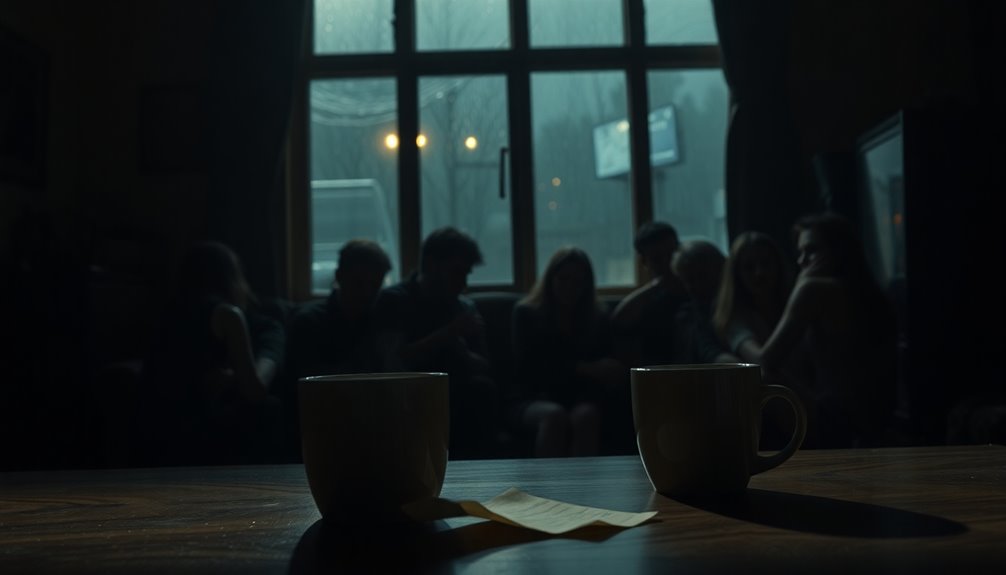In "Leave the World Behind," the twist lies in the blurred lines of trust and survival during a catastrophic event. You think the true danger stems from outside forces, but it's actually the characters' unraveling relationships and underlying tensions that create chaos. The arrival of unexpected visitors intensifies their vulnerabilities, showcasing societal breakdown and revealing deep-rooted biases. The deer symbolize nature's instinctual reactions to human turmoil, enhancing the story's emotional complexity. This ambiguous ending leaves you pondering, proving that sometimes the real survival challenge is understanding human nature itself. Stick around to uncover more gripping insights!
Key Takeaways
- The film's twist lies in the ambiguous nature of the blackout, leaving viewers questioning the cause and implications of societal collapse.
- The deer symbolize nature's response to the chaos, indicating that the unraveling is not just human-made but also a natural reaction.
- Amanda's misanthropy contrasts with George's rational calmness, highlighting differing perspectives on human behavior during crises and revealing deeper character dynamics.
- The film's open-ended conclusion invites multiple interpretations, encouraging discussions about privilege, race, and survival amidst societal breakdown.
- The dramatic changes from the book, including the father-daughter duo and the Tesla pile-up, enhance the film's urgency and relevance to contemporary issues.
Overview of the Film

Exploring the unsettling dynamics of trust and survival, "Leave the World Behind" unfolds as a gripping tale set against the backdrop of a mysterious blackout. You immerse yourself in the lives of Amanda and her family, who are enjoying a vacation in Long Island when their peaceful retreat is interrupted by G.H. and his daughter Ruth. This unexpected visit raises urgent questions about trust and safety amid a growing crisis.
The film brilliantly explores themes of survival and societal breakdown, as unsettling events escalate, like power outages and glitches, leaving the characters grappling with the unknown. As Amanda and Clay confront their fears, you can't help but feel the tension mounting, reflecting real-world anxieties about race, class disparity, and the fragility of modern civilization.
"Leave the World Behind" captivates viewers with its character dynamics and the way it mirrors our current societal landscape. However, the film's ambiguous ending leaves many wondering what it all means, sparking discussions and interpretations long after the credits roll. This blend of personal horror and societal commentary makes the film a thought-provoking experience you won't soon forget. Additionally, the characters' struggle for survival resonates with the concept of resilience that is crucial in navigating crises and uncertainties.
Key Plot Developments
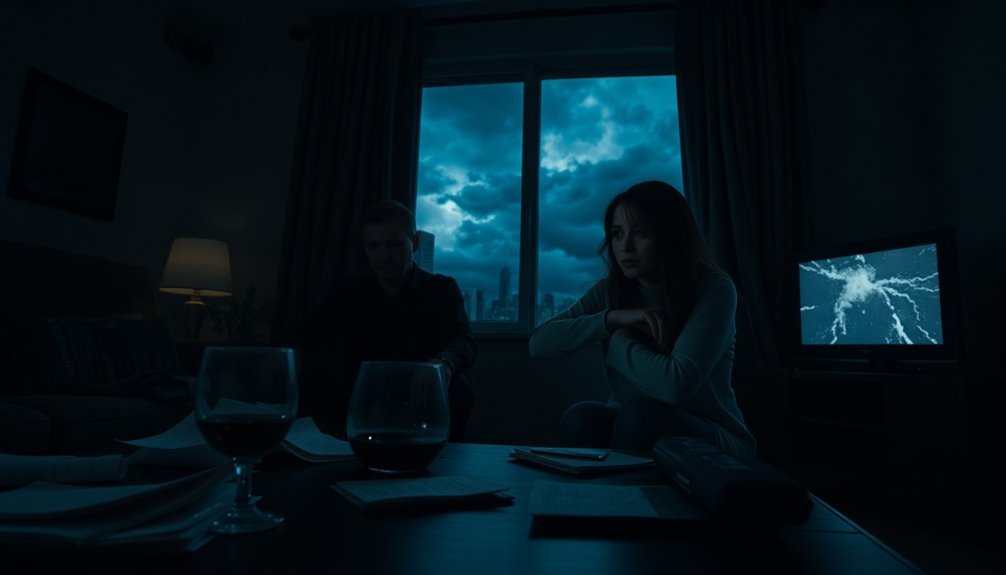
As you watch "Leave the World Behind," you quickly realize things are about to spiral out of control when unexpected visitors show up at the Sandfords' rental.
The tension ramps up as Clay and George race against time to find medicine for Archie, all while Amanda and Ruth search for Rose amidst the chaos unfolding outside.
These key plot developments not only heighten the suspense but also deepen the characters' connections as they navigate a world unraveling before their eyes. Furthermore, their experiences highlight the importance of self-regulation, as they must manage their emotions and reactions during this crisis.
Unexpected Visitors Arrive
The arrival of unexpected visitors profoundly alters the dynamics of Amanda and Clay Sandford's family getaway in Long Island. Just as you settle into the rhythm of relaxation, George and Ruth Scott show up, claiming to be the rightful owners of the rental.
As you witness the initial meeting, you can feel the tension rise; mysterious circumstances surrounding a blackout linger in the air, heightening everyone's anxiety.
George, played by Mahershala Ali, drops bombshells about an escalating crisis, sharing alarming news that hints at a societal collapse beyond the idyllic retreat. This encounter forces Amanda and Clay to confront their biases and fears, revealing how race and privilege complicate their situation.
The unexpected visitors become a catalyst for conflict, leading to distrust that seeps into every interaction.
Navigating this precarious scenario, both families must figure out how to coexist, even as the world outside spirals into chaos. You can't help but feel the weight of their predicament, wondering how far privilege can stretch when faced with true disaster. As tensions rise, the characters are forced to confront their own vulnerabilities and navigate complex interpersonal relationships, leading to unexpected revelations about themselves and their beliefs.
The tension thickens as you realize that this family getaway is anything but relaxing now.
Search for Missing Members
Tension escalates when Amanda and Ruth set out to find Rose, who's gone missing after the power outage. Their frantic search intensifies as they navigate through chaos, embodying the escalating tension of the narrative. During their search, they must also be mindful of the potential for natural signs that could guide them to safety amidst the turmoil.
Meanwhile, Clay and George are on their own mission to find medicine for Clay's son, Archie, adding layers to the crisis and complicating the already dire situation. They are forced to rely on their basic survival skills, such as the ability to navigate and find resources in an unpredictable environment.
As the families split up, you can feel the weight of danger lurking around every corner. They witness bombings in Manhattan, a stark reminder of the severity of their circumstances.
Rose's journey, however, takes an unexpected turn. She manages to find refuge in an abandoned house before discovering a doomsday bunker stocked with supplies and entertainment. This moment highlights her resourcefulness amidst chaos, showcasing the resilience of the characters.
Yet, as the search for missing members unfolds, it culminates in an ambiguous ending, leaving you pondering the fate of Rose and the others. The unresolved nature of their journeys heightens the film's tension, making you crave answers while simultaneously embracing the uncertainty. Additionally, the extreme weather conditions serve as a backdrop to the characters' struggles, amplifying the stakes of their situation.
Character Dynamics and Relationships
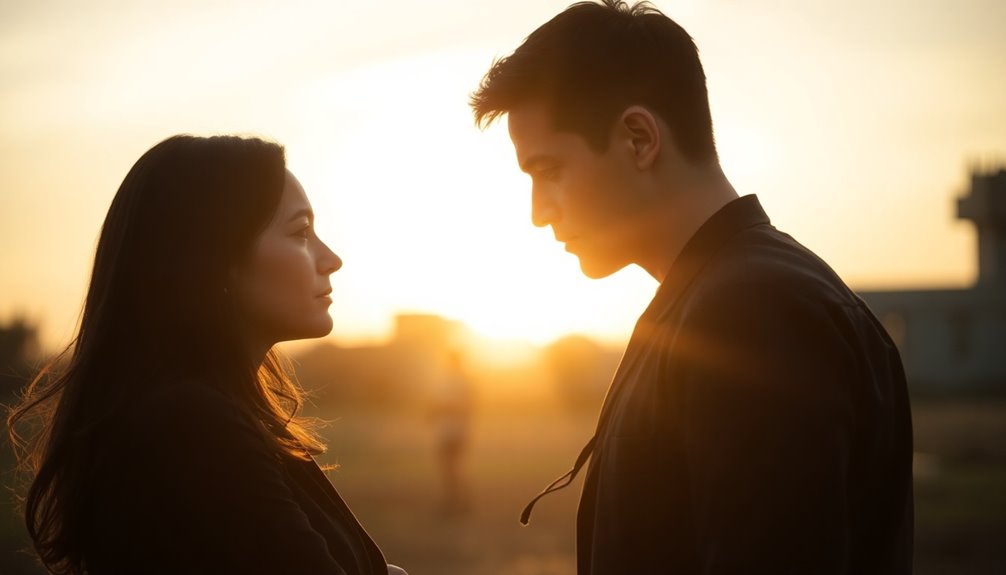
Frequently, character dynamics in "Leave the World Behind" reveal deep-seated tensions and contrasting coping mechanisms among the cast. Amanda's misanthropic nature creates a palpable strain when she interacts with George, whose calm demeanor stands in stark contrast to her anxiety. Meanwhile, Clay's laid-back attitude further complicates matters, showcasing how different approaches to crisis can clash violently.
The relationships among the characters are intricate and layered, especially between Amanda and Ruth, which highlights generational tensions. Amanda's critical nature often rubs Ruth the wrong way, symbolizing a rift in how they perceive the unfolding disaster. In the midst of this turmoil, Rose embodies hope, clinging to the innocence of childhood through her attachment to the TV show *Friends*.
These dynamics can be summarized as follows:
| Character | Coping Mechanism | Tensions |
|---|---|---|
| Amanda | Anxiety and misanthropy | Clashes with George |
| George | Calm and rationality | Frustration with Amanda |
| Clay | Laissez-faire approach | Conflict with Amanda |
| Ruth | Emotional connection | Generational conflict with Amanda |
This table underscores how gender responses also play a role, with men often taking a confrontational stance while women seek emotional bonds.
Symbolism of the Deer

In "Leave the World Behind," the deer aren't just charming woodland creatures; they represent nature's unsettling response to the chaos humans create.
As civilization begins to unravel, these animals reflect our emotional turmoil, reminding you how fragile societal norms can be. Their increasing presence around the house not only heightens the tension but also serves as a stark contrast to our modern advancements, illustrating just how unpredictable the natural world can become in times of crisis.
Nature's Response to Chaos
Nature often responds to chaos in profound ways, and in "Leave the World Behind," the deer serve as a compelling symbol of this reaction. Their unsettling presence amidst the turmoil reflects the fragility of civilization, particularly as societal norms begin to unravel.
You can't help but notice how the increasing numbers of deer surrounding the house create an atmosphere thick with tension. It's almost as if these creatures are responding to the emotional state of the characters, alerting you to the deeper connection between human feelings and nature's instinctual warnings.
These deer embody nature's resilience, thriving even as the world around them succumbs to chaos. While humans grapple with their loss of control, the deer stand as a reminder of survival instincts at play.
As Sam Esmail uses their eerie imagery, you realize that the deer aren't just passive observers; they symbolize a stark contrast to the chaotic environment humans create. Their presence prompts you to reflect on the need to heed nature's cues, urging you to recognize the unsettling reality that it continues to thrive, even when civilization falters.
In this way, the deer become an emotional barometer for the chaos unfolding. Additionally, much like the subconscious power that influences our dreams, the deer's instinctual behavior highlights the profound connection between nature and our internal emotional landscapes.
Fragility of Civilization
Amidst the chaos unfolding in "Leave the World Behind," the deer emerge as powerful symbols of civilization's fragility. Their unusual behavior—surrounding the house—reflects not only nature's response to the collapse of order but also the disintegration of societal norms. You can't help but feel the tension they create, a clear warning of impending danger.
These deer, once seen as harmless, now embody the unsettling reality of survival in a world gone awry. As their numbers increase, you sense the growing unease that permeates the air. This surge signals more than just a shift in nature; it highlights the consequences of human actions on the environment and our desperate attempts to exert control over it.
The deer remind you that, despite our advanced civilization, we remain vulnerable to the unpredictable responses of the natural world. Esmail cleverly uses these creatures as a visual motif to amplify the film's themes, emphasizing that the survival of humanity is intricately linked to recognizing our place within the broader ecosystem.
In this lens, the fragility of civilization becomes glaringly evident, urging you to reflect on the delicate balance between man and nature.
Human Emotional Reflections
The deer in "Leave the World Behind" evoke a deep emotional response, forcing you to confront the unsettling reality of a world in turmoil. As societal norms unravel, these creatures symbolize nature's response to chaos, highlighting the fragility of civilization. Their unusual behavior and increasing presence around the house reflect a profound loss of control over the natural world, amplifying the characters' emotional states as they grapple with fear and uncertainty.
When Rose observes the deer—an observation others dismiss—it signifies a shift from technological reliance to a deep connection with nature and its warnings. This moment underscores the importance of human emotional reflections during crises, as the characters realize that their safety is intertwined with the environment around them.
Director Sam Esmail uses the deer as unsettling imagery, transforming what should be peaceful creatures into symbols of danger and foreboding.
In the "Leave the World Behind" ending explained, the deer encapsulate the tension between humanity and nature, serving as a reminder that, in times of turmoil, the line between security and vulnerability can blur, leaving us to ponder our place in this complex ecosystem.
Themes of Nature and Nostalgia
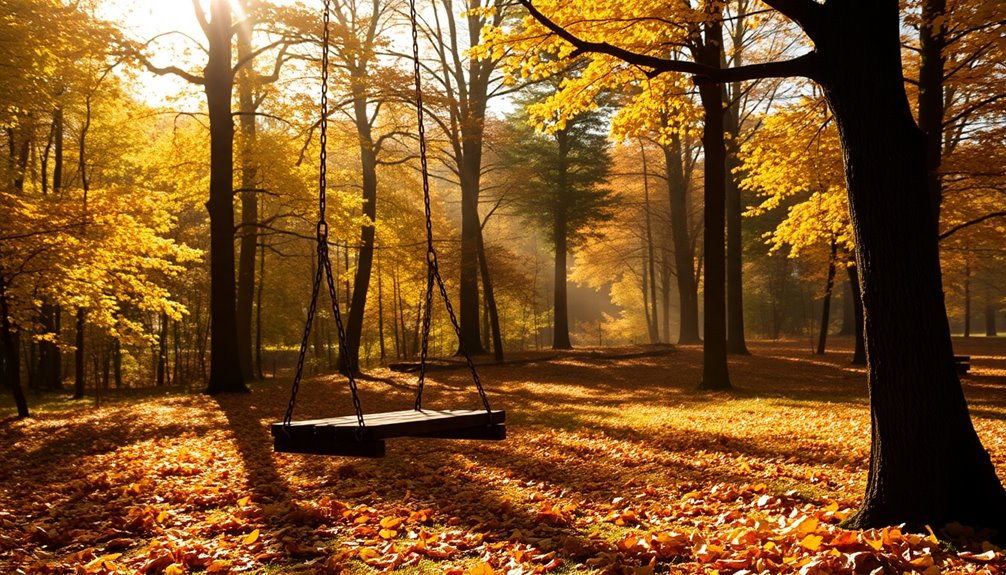
Juxtaposing the chaos of a technological collapse with the resilience of the natural world, *Leave the World Behind* weaves themes of nature and nostalgia throughout its narrative. You can see how the appearance of deer and flamingos symbolizes nature's persistence, standing strong against the backdrop of civilization's fragility. As the chaos unfolds, Rose finds comfort in watching "Friends" on the TV screen, providing an escape into simpler times. This longing for nostalgia highlights an emotional connection to a pre-digital era, reminding you of the warmth of shared moments over physical media.
The film contrasts these themes beautifully, encapsulating the fragility of human existence amidst looming dangers. Here's a quick look at how these themes interact:
| Theme | Example |
|---|---|
| Nature | Deer and flamingos symbolize resilience |
| Nostalgia | Watching "Friends" for comfort |
| Chaos | Technological collapse |
| Escapism | TV screen as a refuge |
As you reflect on these elements, you realize that the story not only showcases a crisis but also invites you to appreciate the beauty and comfort found in nature and cherished memories.
Ending Analysis and Implications
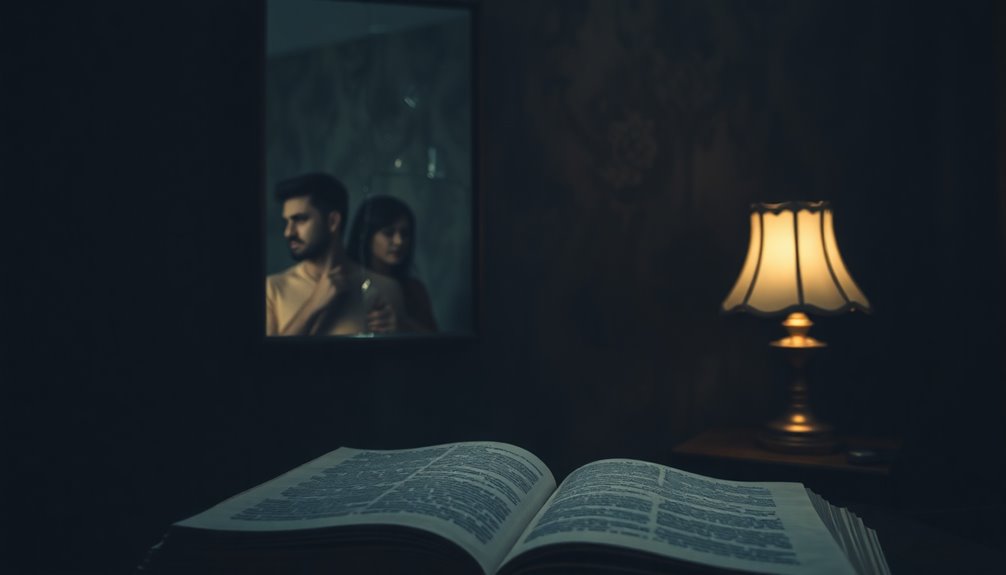
As you reach the film's conclusion, the ambiguity of the ending leaves you grappling with a sense of uncertainty about the characters' fates. This unresolved tension reflects a broader critique of modern society's reliance on technology, embodied by Clay, who becomes oblivious to the lurking dangers around him.
The ending challenges you to contemplate how this dependence creates a disconnect from nature, which, despite the chaos, remains resilient, as shown by the deer and flamingos that appear throughout the film.
You can't help but feel nostalgic when Rose opts to watch "Friends" in the bunker, a poignant reminder of normalcy amidst societal collapse. This moment underscores the film's exploration of trust—both in others and in the world around you.
The interactions between the families reveal the complexities of race and privilege, inviting you to reflect on how these societal issues shape human behavior during crises.
Ultimately, the ambiguous ending serves as a mirror, prompting you to examine your own relationships with technology, nature, and trust, leaving you with more questions than answers about what it means to truly "leave the world behind." Additionally, the film's portrayal of emotional distress echoes the realities of narcissistic abuse recovery, highlighting how our connections can be fraught with psychological complexities.
Differences From the Book

Several key differences between the film adaptation of "Leave the World Behind" and the original book shape the overall narrative and themes. For starters, in the film, G.H. and Ruth are portrayed as a father-daughter duo, while in the book, they're a couple. This shift alters the dynamic considerably, affecting how you perceive their relationship during the crisis.
The film dives deeper into disaster elements, including a dramatic Tesla pile-up that amplifies the chaos, which isn't present in the book. This addition heightens the tension, pulling you further into the unfolding calamity.
There's also a subplot of characters binge-watching "Friends," offering a layer of escapism that the novel lacks.
What's more, the book wraps up with Rose returning home with supplies, but the film ends on an ambiguous note, leaving her watching "Friends" in a doomsday bunker.
Author Rumaan Alam has expressed approval of these changes, highlighting their creativity and relevance to contemporary themes. These differences from the book not only alter character arcs but also enhance the film's emotional resonance, inviting you to reflect on modern anxieties in a unique way.
Audience Reception and Speculation

Audience reception for "Leave the World Behind" has been a mixed bag, with a 75% rating on Rotten Tomatoes highlighting both its thematic depth and critiques of pacing.
While many viewers appreciated the film's realistic portrayal of chaos and its exploration of societal issues, others felt let down by the ambiguous ending. You might find it intriguing that some fans were expecting a dramatic payoff but instead encountered an anti-climactic conclusion, leaving them scratching their heads.
The film’s open-ended nature has sparked a wave of viewer curiosity, driving discussions about unresolved plot points and potential character fates. This ambiguity has kept audiences engaged long after the credits rolled, as they speculate on what might happen next for the characters. Fans have taken to social media platforms to share their theories, with many highlighting a particularly intriguing moment reminiscent of a Julia Roberts new movie twist that left them guessing. This element of surprise not only enhances the viewing experience but also encourages repeat viewings, as audiences seek to uncover hidden clues and deeper meanings. As speculation swirls, the film’s enigmatic conclusion ensures that it remains a topic of conversation, showcasing the power of storytelling that elicits such fervent engagement.
Critical acclaim has praised the film for tackling complex themes like race and privilege, prompting conversations about human behavior in crisis situations.
Ultimately, the mix of appreciation for its depth and frustration over its unresolved mysteries makes "Leave the World Behind" a compelling piece for analysis.
It's a film that invites you to think and discuss, ensuring its place in ongoing conversations about modern cinema.
Frequently Asked Questions
What Is the Twist in "Leave the World Behind"?
The twist in "Leave the World Behind" reveals a catastrophic cyber attack that shatters the characters' sense of security.
As the chaos unfolds, you realize how fragile modern civilization truly is.
Amanda and George's interactions highlight societal tensions, while eerie wildlife behavior foreshadows the escalating turmoil.
Ultimately, the film critiques our dependence on technology, showing how ignorance can spiral into disaster when we rely too heavily on digital media for information.
What Is the Message Behind the Movie "Leave the World Behind"?
Did you know that over 90% of Americans feel anxious about the future due to technology's impact?
"Leave the World Behind" captures this sentiment, showcasing how our reliance on devices can blind us to real dangers lurking just outside.
The film dives into trust, survival, and societal divides, illustrating how personal fears reflect larger crises.
What Actually Happened at the End of Leave the World Behind?
At the end of "Leave the World Behind," you're left in a whirlwind of uncertainty.
Rose clings to the familiar comfort of watching Friends while chaos erupts outside. The loud noises hint at a world crumbling, leaving you questioning the fate of Amanda, Clay, and George.
It's a stark reminder of the fragility of normalcy. Ultimately, the ending emphasizes hope amid despair, suggesting that comfort can still exist, even in the darkest times.
Why Did Archie's Teeth Fall Out in Leaving the World Behind?
Did you know that nearly 50% of children experience dental anxiety?
In "Leave the World Behind," Archie's teeth falling out symbolizes more than just a dental issue; it reflects the chaos and instability surrounding them.
As strange noises and apocalyptic events unfold, his tooth loss highlights the vulnerability of kids in crises.
This moment deepens emotional stakes, showing how fear can physically manifest, leaving both Archie and the audience feeling unsettled.
Conclusion
In the end, "Leave the World Behind" leaves you with lingering questions, much like the mist that hangs over a quiet forest at dawn. As the characters confront their deepest fears, you can't help but feel the weight of nostalgia and uncertainty in the air. The twist you missed isn't just a plot device; it's a mirror reflecting our own vulnerabilities. So, as you ponder the film's implications, remember: sometimes, the scariest truths hide in the shadows of everyday life.
